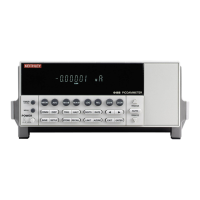Model 6485 Picoammeter Instruction Manual IEEE-488 and SCPI Conformance Information G-7
Trigger-on-talk
Trigger-on-talk functionality has been added for the 488.1 protocol. If a query has not
been received by the instrument, the 6485 will automatically assume a READ? command
has been sent when it is addressed to talk. This technique increases GPIB speed by
decreasing the transmission and parser times for the command.
Trigger-on-talk is extremely useful in the single-shot reading mode (*RST default) and is
the main reason for a >2x speed improvement over the SCPI protocol.
The ARM:SOUR BUS and ARM:COUN INF commands are not supported by READ?
with the 488.1 protocol selected. If you send one of these commands, a DCL or IFC may
be required to reset the GPIB.
Message available
The MAV (message available) bit in the Serial Poll byte will be set when the query is fin-
ished being processed, not when there is data available in the output buffer (as with the
SCPI protocol). For the 488.1 protocol, output data will not be formatted until the first
request for data is received. This delay may cause unexpected time-outs when using SRQ
on MAV for queries that take a long time to execute.
General operation notes
• The TALK, LSTN, and SRQ annunciators are not functional in the 488.1 protocol.
This speeds up data throughput greatly. The REM annunciator still operates since it
is critical to fundamental GPIB operation.
• If the unit is in REMote, the GTL command may not put the 6485 into the local
mode. Only the front panel LOCAL key is guaranteed to operate, if not in local
lockout (LLO). GTL will still disable LLO.
• IEEE-488 bus commands and features (GET, IFC, SDC, DCL, LLO, Serial Poll,
and SRQ) are still fully supported.
• Multiple TALKs on the same query are supported as in the SCPI protocol. This fea-
ture is useful when reading back long ASCII strings.
SRQ when buffer fills with 200 readings
The following QuickBasic program (Figure G-2) will store 200 readings in the buffer.
When the buffer fills to the set amount (200 readings), an SRQ will occur and a message
will be displayed on the computer to indicate the event.

